Bamboo fencing offers a natural, eco-friendly solution that’s both durable and visually striking for your garden. You’ll appreciate its versatility—working well with various garden styles from tropical to modern. It’s relatively lightweight, making installation easier than traditional fencing materials, yet remains sturdy with proper treatment and maintenance. Bamboo also provides excellent privacy while allowing gentle airflow and creating a serene, organic aesthetic. Discover how this sustainable material can transform your outdoor space with minimal environmental impact.
Essential Bamboo Fence Tools and Materials
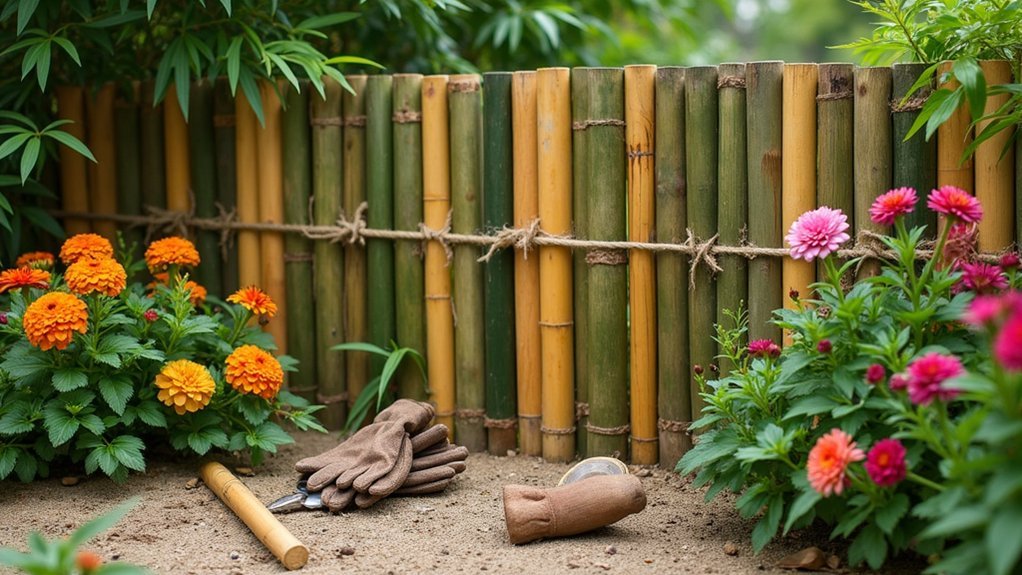
Three categories of tools and materials are essential for installing a bamboo fence: basic installation tools, structural materials, and finishing items.
For installation, you’ll need a cordless drill with a tapered drill bit, pliers, diagonal cutters, a level, and a hammer. Don’t forget a power screwdriver to speed up the process.
Your structural materials should include bamboo panels or rolls, treated lumber (4×4s for posts and 2×4s for rails), concrete mix for setting posts, and tie wire for securing bamboo. Remember to use galvanized tie wire to prevent rusting and ensure long-term durability of your fence attachment.
For specific surfaces like brick, consider a powder-actuated tool or Topcon system.
Finally, add finishing touches with 2×6 lumber for top caps, deck screws or wood nails, sealants for weather protection, and trim materials to conceal wire connections.
Preparing Your Garden Space for Bamboo Installation
Proper site assessment forms the foundation of a successful bamboo fence installation, requiring you to evaluate dimensions, terrain, and underground utilities before breaking ground.
You’ll need to mark clear boundaries with stakes to define your fence line and guarantee ideal spacing of support posts.
Taking time to assess your space will pay dividends in structural integrity and longevity of your garden’s bamboo feature. Remember that bamboo fences come in standard 8 feet lengths that can be customized to fit your garden’s specific dimensions.
Site Assessment Fundamentals
Beginning your bamboo fence project with a thorough site assessment will save you countless headaches down the road.
Take time to evaluate your soil type, as this determines how deep you’ll need to place support poles for ideal stability.
Ensure your ground is completely level and free from obstructions before installation begins. Remove all debris, rocks, and unwanted vegetation that could interfere with your fence’s foundation.
Don’t overlook local weather patterns—they’ll influence both your material choices and installation timing.
Mark your boundary lines clearly and plan pole intervals for structural integrity. Remember to check for underground utilities before digging.
Having the right tools on hand—measuring tape, post-hole digger, and level—will streamline the installation process and help you create a bamboo fence that’s both beautiful and durable.
Consider installing containment barriers if using running bamboo varieties as they spread aggressively underground and could potentially create issues with neighboring properties.
Setting Proper Boundaries
Before breaking ground on your bamboo fence installation, establishing clear boundaries defines not only the aesthetics of your garden but also prevents potential conflicts with neighbors and future maintenance headaches.
You’ll need to guarantee your garden space is properly prepared. Start by leveling the ground and removing all debris from the fence line. Then dig holes deep enough for your support poles, considering your local soil type and wind conditions. Position your fence post holes approximately every 6-7 feet for optimal stability and panel support.
| Preparation Task | Why It Matters |
|---|---|
| Level the ground | Guarantees fence stability |
| Remove debris | Creates sturdy foundation |
| Dig proper depth | Prevents wind damage |
| Consider soil | Affects support needs |
| Manage moisture | Extends fence lifespan |
For running bamboo varieties, don’t forget to install a root barrier to prevent unwanted spreading that could create boundary disputes later.
Step-by-Step Roll Bamboo Fence Assembly
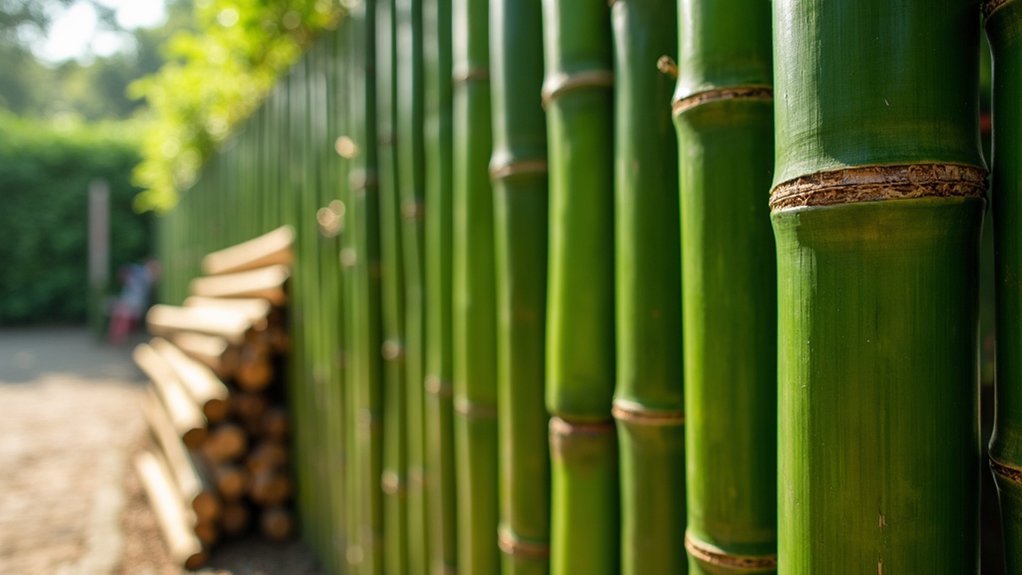
Before beginning your bamboo roll fence installation, you’ll need a cordless drill, galvanized wire, pliers, and a fine-tooth miter saw to guarantee proper assembly.
Start by measuring your space and cutting the bamboo rolls to fit, pre-drilling holes to prevent splitting during attachment. Remember to suspend natural bamboo at least 2 inches off the ground to prevent water damage and extend its lifespan.
You’ll then secure the rolls to your posts using galvanized wire, making sure to keep everything level and trimming any excess material for a clean finish.
Tools and Preparations
Successful bamboo fence installation requires five essential tools and several key materials before you start the assembly process.
You’ll need pliers and diagonal cutters for handling tie wires, a cordless drill for pre-drilling holes, plus a level and tape measure to guarantee accurate placement.
Gather your materials including bamboo panels or rolls, 14-16 gauge tie wire for securing panels, wooden posts (both 4’x4′ and 2’x2′) for structural support, and concrete mix for anchoring posts.
Don’t forget scrap lumber for reinforcement.
Before installation, clear your workspace of obstacles, measure the area carefully, and select bamboo that suits your climate conditions.
Wear protective gear like gloves and safety glasses throughout the process.
Consider your budget constraints and check local building codes to verify your fence meets regulatory requirements.
Having an assistant during installation helps ensure your bamboo fence maintains uniform level placement throughout the entire project.
Installation Process
The installation of your bamboo fence involves five key stages that transform loose materials into a sturdy, attractive barrier.
Begin by measuring your area carefully, marking post positions and planning for any panel overlaps. Next, secure your framework using galvanized wire to attach fencing to posts while maintaining proper tension.
When customizing your panels:
- Cut length with heavy-duty scissors by snipping connecting wires
- Use a miter saw with 60+ teeth blade for vertical cuts
- Run saw at full speed before cutting to prevent splitting
- Seal cut ends immediately to prevent unraveling
Attach rolls by pre-drilling holes every 12 inches in mounts, securing with screws or wire.
Finally, make adjustments by checking for gaps, trimming protruding wires, and testing stability with light pressure.
Creating Privacy Screens With Split Bamboo Panels
When considering garden privacy solutions, split bamboo panels offer an ideal combination of natural aesthetics and practical functionality. They’re lightweight yet durable, making installation a simple DIY project for most homeowners while providing effective screening from neighboring views. Forever Bamboo provides sustainable bamboo products for both residential and commercial applications.
| Feature | Benefit |
|---|---|
| Natural Appearance | Blends harmoniously with garden surroundings |
| Sustainable Material | Eco-friendly choice with low environmental impact |
| Versatile Design | Available in various heights (4-8ft) and finishes |
You’ll appreciate the cost-effectiveness compared to traditional fencing materials while enjoying the distinctive rustic charm bamboo brings to your outdoor space. For maximum durability, consider combining bamboo with complementary materials or selecting carbonized options that offer enhanced weather resistance. With proper maintenance, your bamboo privacy screen will serve as an attractive garden boundary for years.
Securing Bamboo Posts for Maximum Stability
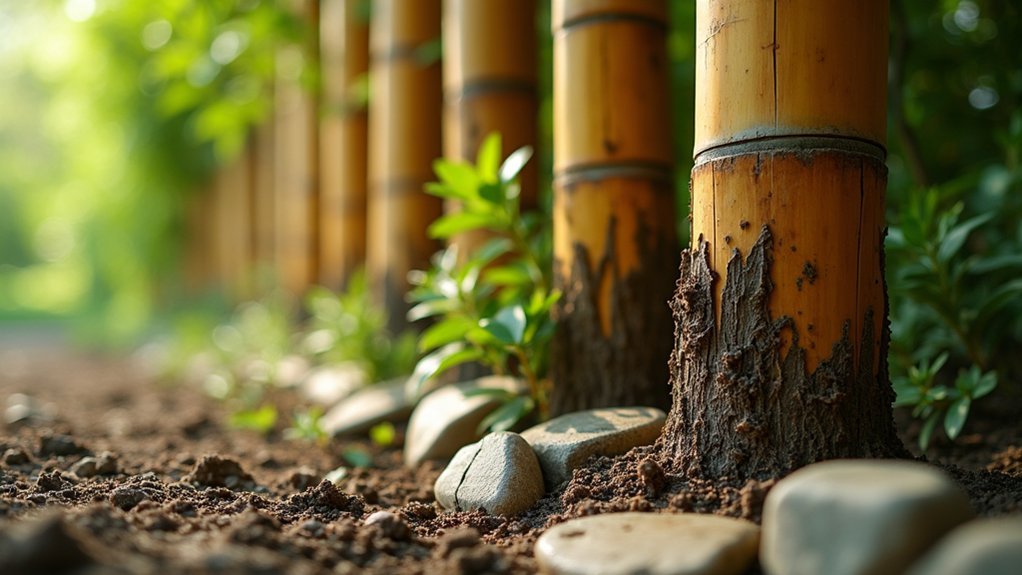
Securing your bamboo posts properly forms the foundation of a stable garden fence that will stand the test of time.
You’ll achieve maximum stability by embedding posts at least one-third of their length into the ground, preferably with a concrete foundation that prevents moisture damage and shifting.
For exposed areas that face strong winds, implement cross-bracing techniques between posts to distribute lateral forces and prevent leaning or toppling. Regular inspection of your bamboo fence will help identify and address any loose panels before they compromise the entire structure’s integrity.
Deep Post Embedment
Proper post embedment forms the foundation of any durable bamboo fence, with stability directly linked to how deeply and securely you anchor your posts. For standard installations, dig holes at least 12 inches deep, slightly wider than your bamboo poles, and position them 6-8 feet apart to align with panel dimensions.
Consider these critical factors when setting your posts:
- Suspend natural bamboo 2 inches above soil level to prevent rot, especially in moisture-prone areas.
- Create a 4-6 inch drainage layer of gravel beneath posts to prevent water pooling.
- Pack soil or gravel firmly around posts, eliminating air pockets that compromise stability.
- Increase embedment depth to 18-24 inches in high-wind regions for extra reinforcement.
Check post levels during installation to guarantee perfect vertical alignment throughout your fence line. When using metal frame kits, you’ll gain additional structural support while protecting your bamboo from ground moisture.
Concrete Foundation Benefits
Beyond basic soil embedment, concrete foundations offer superior stability and longevity for bamboo fence posts. They create an essential moisture barrier that prevents ground water from wicking into your bamboo, dramatically reducing rot risk.
For maximum effectiveness, seal your bamboo with epoxy or asphalt coating before embedding it in concrete. Add rebar extending 3+ feet into the foundation to enhance load-bearing capacity and wind resistance. Natural stones can be placed between the concrete and bamboo as an additional moisture barrier with aesthetic appeal.
Remember to create footings wider than your bamboo’s diameter to distribute weight evenly across unstable soils.
Allow your concrete to cure properly—2-4 weeks with daily watering—to guarantee peak strength. This foundation approach also provides thermal separation between soil and bamboo while combining concrete’s compressive strength with bamboo’s natural flexibility, creating a durable, long-lasting fence system.
Cross-Bracing Techniques
While your bamboo fence posts provide the framework, effective cross-bracing transforms your structure from merely standing to genuinely stable.
By installing diagonal reinforcements, you’ll counteract lateral forces from wind and weight, preventing the dreaded parallelogram deformation that can collapse rectangular panels.
For maximum strength in your bamboo fence, consider these key bracing strategies:
- Secure bracing ends at bamboo’s natural nodes for superior grip and split prevention
- Employ tourniquet lashing with minimum three tight wraps at each connection point
- Install crossed diagonal braces in “X” patterns to distribute stress across multiple points
- Combine horizontal wooden braces with bamboo diagonals for layered reinforcement
Consider implementing the drilled lashing joint technique, which allows you to connect multiple cross-poles to an upright for enhanced structural integrity.
Remember to re-tension your lashings seasonally as materials naturally shrink and expand with weather changes.
Natural Weatherproofing Techniques for Bamboo Fencing

Because bamboo fences naturally resist moisture, you can enhance this inherent quality with proper weatherproofing techniques.
Start by thoroughly cleaning your fence with a bleach-water solution and allow it to dry completely before applying any sealants.
For ideal protection, choose between tung oil, which penetrates deeply, or spar urethane for robust defense against UV rays and water.
Marine epoxy works well in harsh conditions, while linseed oil enhances bamboo’s natural beauty.
Apply your first treatment immediately after installation, then maintain every 18-24 months.
You’ll need to adjust this schedule based on your local climate.
Regular maintenance prevents color fading to gray and greatly extends your fence’s lifespan.
These simple weatherproofing steps will preserve your sustainable bamboo fence for years to come.
A strategic installation that leaves a gap at the bottom of your fence will prevent moisture buildup and reduce the risk of rot.
Designing Curved and Corner Sections in Your Bamboo Fence
Creating curved sections and corners with bamboo transforms an ordinary garden fence into a visually enchanting feature. Bamboo’s natural flexibility allows you to craft gentle bends that soften your garden’s angular lines while maximizing irregular spaces.
When designing curved sections, consider:
- Using bamboo’s natural bend properties by gently flexing and securing with wire or traditional lashing techniques.
- Building a sturdy framework first, then attaching curved elements in layers for better stability.
- Reinforcing corners with diagonal supports in a Yarai-style design to prevent sagging.
- Combining bamboo with complementary materials like stone or incorporating climbing plants for enhanced visual appeal.
For corners, position posts securely and select appropriate bamboo thickness to maintain structural integrity while preserving the fence’s aesthetic balance. Integrating Rup-Rup technique with V-shaped cuts along bamboo poles allows for more dramatic curves while maintaining strength when bundled together.
Bamboo Gate Construction Methods
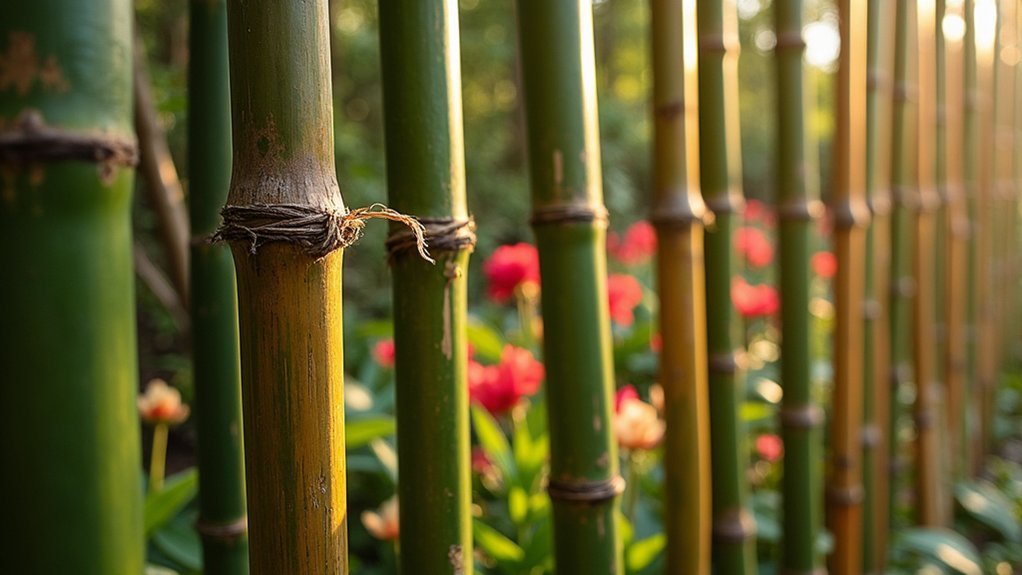
Constructing a bamboo gate requires both technical precision and artistic sensitivity to complement your fence design. Begin by selecting mature, straight poles and cutting them to your desired lengths. Clean them thoroughly to remove dirt and residues before drying properly to prevent future warping.
The art of bamboo gate-making balances precision with creativity, beginning with careful selection of materials that will define your garden’s character.
For authentic Japanese-inspired gates, use pegged joints instead of metal hardware. Join framework pieces with hardwood pegs or bamboo dowels for structural integrity. Arrange horizontal rails alternating thick and thin ends, with the thickest piece at the top.
Create visual interest by fabricating lattice panels from split bamboo or using whole poles for solid gates. Always wear heavy leather gloves when splitting bamboo to protect your hands from sharp edges and splinters. Assemble your gate on the ground first to check alignment before installation.
This hardware-free construction approach guarantees your gate maintains an organic aesthetic while providing durability and function.
Decorative Elements to Enhance Your Bamboo Fence
Five key decorative elements can transform your bamboo fence from a simple boundary into a stunning garden feature.
You’ll find bamboo’s natural texture blends seamlessly with various garden styles while offering eco-friendly appeal. Consider incorporating carbonized or black bamboo for a sophisticated, modern look, or keep the natural finish for a more traditional appearance. Our premium Tatami Bamboo Paneling Carbonized provides an elegant 4 x 50 dimension perfect for extended garden sections.
Creative layouts greatly impact your fence’s visual appeal:
- Layer your bamboo with thatch or tropical matting for an exotic, textured look
- Integrate outdoor lighting to create dramatic nighttime silhouettes
- Hang wind chimes or string lights for added sensory appeal
- Plant colorful vegetation along the fence line, allowing plants to weave between bamboo sections
These additions will enhance your bamboo fence’s beauty while maintaining its natural character and complementing your garden’s existing elements.
Seasonal Maintenance Tips for Long-Lasting Bamboo Barriers
Your beautiful bamboo fence won’t maintain its charm without proper care throughout the year.
Adjust your maintenance routine with the seasons—conduct thorough spring cleaning to remove winter grime, apply additional UV-protective sealants during summer, and secure loose fasteners before fall winds arrive.
Winter demands more frequent inspections as moisture can damage bamboo. Make sure your fence has proper ground clearance year-round to prevent rot. Reapply weatherproof sealants every 1-3 years depending on your climate conditions.
Check metal brackets for rust and tighten fasteners annually. After cleaning with detergent or specialized bamboo cleaners, always allow a full two-day drying period before applying treatments.
This seasonal vigilance will greatly extend your bamboo fence’s lifespan and preserve its natural beauty.
Frequently Asked Questions
How Does Bamboo Fencing Impact Local Wildlife and Ecosystems?
Bamboo fencing impacts wildlife by potentially blocking movement pathways but can be designed with gaps for connectivity. You’ll find it’s an eco-friendly alternative that provides habitat, reduces human-wildlife conflicts, and doesn’t contain toxic chemicals when mature.
Can Bamboo Fencing Increase My Property’s Resale Value?
Bamboo fencing can boost your property’s resale value by enhancing curb appeal, attracting eco-conscious buyers, and creating unique aesthetics. It’s cost-effective, low-maintenance, and provides a competitive edge in the housing market.
Will Bamboo Fencing Affect My Homeowners Insurance Rates?
Bamboo fencing typically won’t affect your homeowners insurance rates. Insurance premiums are mainly determined by location, property condition, and claims history rather than fence material choices, unless the fence considerably enhances security.
How Does Bamboo Compare to Composite Fencing Materials?
Bamboo is eco-friendly and provides a natural aesthetic, while you’ll find composite fencing more durable and low-maintenance. Bamboo requires more upkeep but offers unique style, whereas composite resists weather damage and lasts longer.
Are There Any Cultural Considerations When Installing Bamboo Fencing?
Respect Japanese design principles when installing bamboo fencing. You’ll honor its cultural significance as a symbol of simplicity and connection to nature. Consider traditional techniques that showcase craftsmanship and create meditative private spaces.
In Summary
You’ve discovered bamboo’s perfect blend of sustainability, aesthetics, and practicality for your garden boundaries. Whether you’ve installed roll fencing, constructed a privacy screen, or designed a custom gate, your bamboo fence will serve you well with minimal upkeep. Remember to treat it annually and check for wear regularly. With proper care, you’ll enjoy your eco-friendly, natural bamboo fence for many years to come.

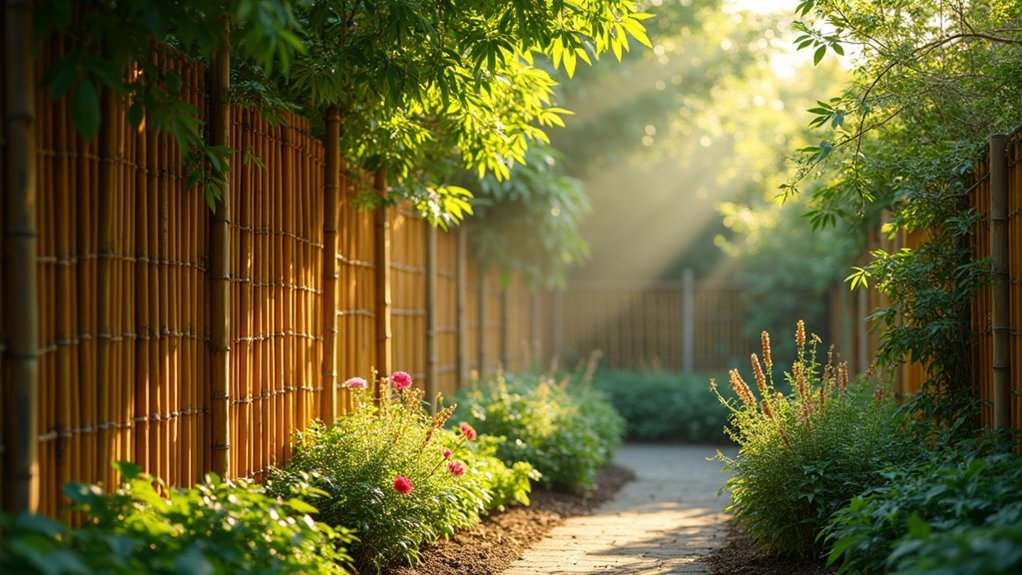



Leave a Reply